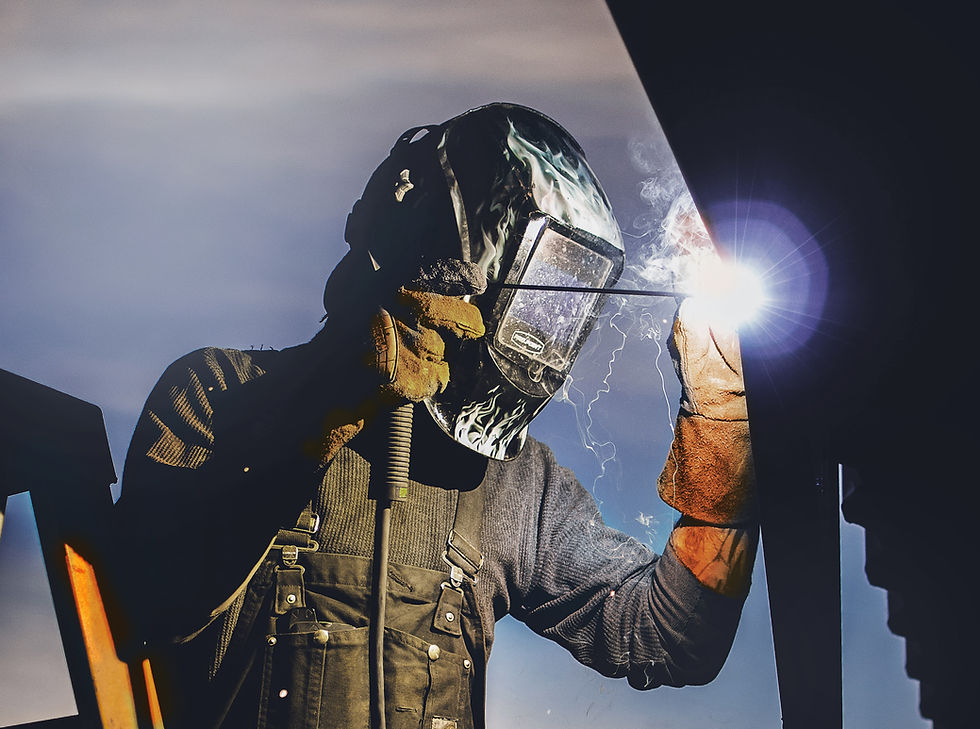Welding Processes: What are my options and how do they differ?
- Charles McCarthy
- Feb 22, 2024
- 3 min read
Updated: Jul 23, 2024

Welding, is the most fundamental skill in metalworking. Under the umbrella of the term welding there are four main process types used by shops similar to ours these processes are MIG (Metal Inert Gas), FCAW (Flux Core Arc Welding), TIG (Tungsten Inert Gas), and SMAW (Shielded Metal Arc Welding). Each method has distinct characteristics that influence its suitability for different applications.
In this article, we'll cut through the complexity to examine the practical differences and considerations surrounding MIG, TIG, and Stick welding. By understanding the advantages and disadvantages of each technique, you can make informed decisions for your welding projects when purchasing or designing parts.
TIG Welding
TIG (Tungsten Inert Gas) welding, known for its precision and versatility, involves the use of a non-consumable tungsten electrode to create the weld. Shielding gas, typically argon, protects the weld area from atmospheric contamination, ensuring clean and strong welds. One of the primary advantages of TIG welding is its ability to produce high-quality welds on a variety of metals, including stainless steel, aluminum, and copper, making it suitable for diverse applications from aerospace to automotive industries. TIG welding offers exceptional control over the welding process, allowing welders to achieve intricate and detailed welds with minimal spatter and distortion. However, TIG welding requires a significant level of skill and expertise, as it demands precise control of the torch and filler rod simultaneously. Additionally, the process is slower compared to other welding methods, which may not be ideal for high-production jobs.

MIG Welding
MIG (Metal Inert Gas) welding, characterized by its speed and simplicity, employs a continuous solid wire electrode and a shielding gas, typically a mix of argon and carbon dioxide, to create the weld. This semi-automatic process is widely favored for its efficiency and ease of use, making it suitable for a wide variety of applications. One of the primary advantages of MIG welding is its high deposition rate, allowing for rapid welding of thick materials and large projects. The process also generates minimal slag, reducing the need for post-weld cleaning. Additionally, MIG welding can be easily automated, further enhancing productivity in mass production environments. However, MIG welding does not provide the same level of precision as TIG welding, particularly for thin materials or intricate welds.

Flux Core Welding
Flux-cored arc welding (FCAW) is a versatile welding process that utilizes a tubular wire electrode filled with flux materials. Unlike MIG welding, FCAW doesn't necessarily require an external shielding gas, as the flux inside the electrode creates a protective atmosphere as it melts. This feature makes flux-cored welding particularly suitable for outdoor and windy conditions where gas shielding might be compromised. One of the main advantages of flux-cored welding is its high welding speed and deep penetration capabilities, making it ideal for welding thick materials and in heavy-duty applications such as construction, shipbuilding, and pipeline welding. Moreover, flux-cored welding is more forgiving of surface contaminants like rust and mill scale compared to other processes, resulting in fewer pre-weld cleaning requirements. However, flux-cored welding produces more smoke and spatter compared to other processes, which can lead to increased cleanup time and a less aesthetically pleasing weld appearance. Additionally, the cost of flux-cored electrodes may be higher than solid wire electrodes used in MIG welding, and the process typically requires more skill and experience to master effectively.

Stick Welding (SMAW)
Stick welding, formally known as Shielded Metal Arc Welding (SMAW), remains a cornerstone of welding technology, renowned for its simplicity and versatility. When stick welding, an electrode coated in flux is used to create the weld, providing both the filler metal and the shielding gas necessary to protect the weld pool from atmospheric contamination. This self-contained nature makes stick welding highly portable and suitable for outdoor and remote welding applications where other methods may be impractical. One of the key advantages of stick welding is its ability to weld a wide range of materials, including carbon steel, stainless steel, cast iron, and various alloys, making it a preferred choice in industries such as construction, fabrication, and maintenance. Additionally, stick welding excels in welding dirty or rusty materials, thanks to the flux coating's ability to cleanse the weld area as it burns. However, stick welding typically produces more spatter and slag compared to other processes, requiring additional cleaning and post-welding operations. Moreover, the process demands a steady hand and precise technique to control the arc and produce quality welds, making it less forgiving for beginners compared to other welding methods like MIG or flux-cored welding.

What process should I select for my project?
Answering this question is nearly impossible without first understanding all of the variables required. If you are running into issues deciding which processes to use please feel free to reach out to us and we will do our best to guide you in the right direction.


